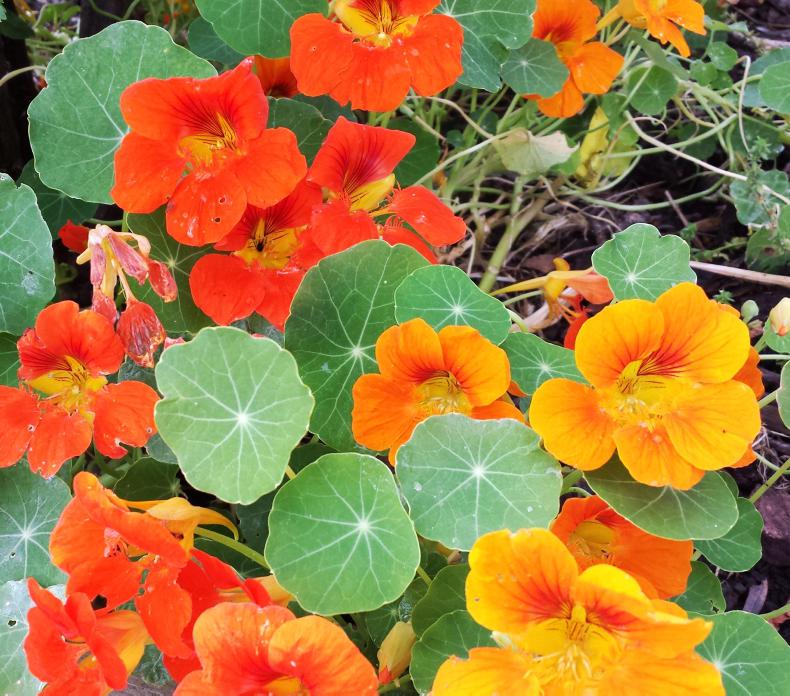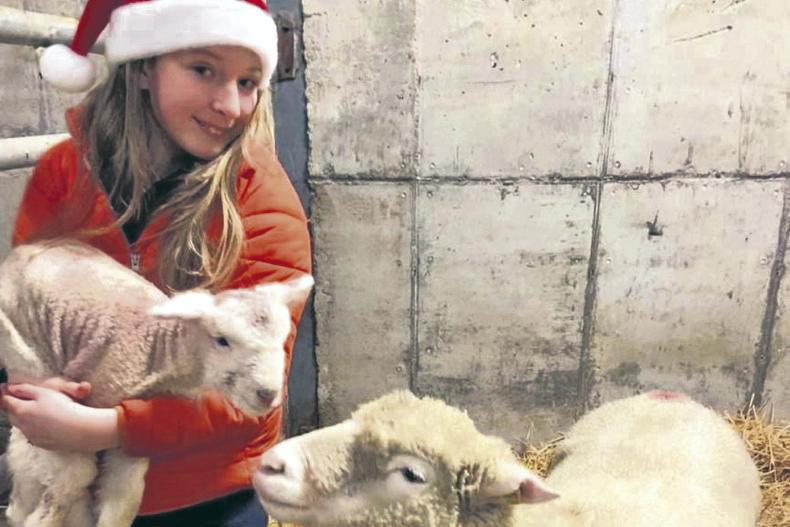The kind of iris that flowers in May is the bearded iris, normally seen with blue or purplish flowers. Bearded iris is a medium to tall plant, seen growing in a clump at the middle or front of mixed borders. It is very common in its blue forms, and there are many other colours too. In a country garden, the iris provides colour and softness. It comes into flower just as the fresh new foliage flushes fully open on trees and shrubs, the blue iris colour making a wonderful contrast with the fresh and varied green colours of the expanding leaves, not least its own.

Iris germanica.
The most common bearded iris is the German iris, Iris germanica, which has blue flowers, shading to violet. It gets the common name “bearded iris” from the “beard” of bristly growth on the three lower petals. The “German” part of the name comes from the idea that it originated in Germany, although it is more likely to have originated in Italy and the Mediterranean zone.
The German iris is considered to be a hybrid and may have arisen in cultivation. A similar species, Iris pallida, has pale blue flowers and this kind – or perhaps it is a pale blue version of the German iris – is often seen in old gardens. These species are probably mixed up, or only now exist as hybridised gardens forms, but blue-flowered forms of German iris are very common, although the shade of blue may vary somewhat. The actual breeding does not matter much, except to enthusiasts. A third species from the countries around the Adriatic Sea is Iris variegata, which has yellow top petals and striped lower petals. It is thought that this species was hybridised with the two blue kinds and has given rise to many of the hybrids that exist today as a result of very extensive back-crossing and the introduction of other species.
A vast range of tall bearded irises exists. There are lots of intermediate and dwarf irises too but somehow these lack the stature and the grandeur of the taller kinds. In any case, the taller kinds are more suitable for rural gardens where their size will be an advantage. The shorter kinds are more suitable for smaller town gardens where space is more limited. The colours of the bearded irises are very beautiful, ranging from palest blue to deepest indigo, rosy-lavender to deep maroon, and yellow to deep brown.
Choose the positions for irises with some care, where the flowers will be seen to good effect
There are many kinds with two colours, others with stripey effects, and some with frilly petals. The most beautiful are the blues and the lighter pinkish lavender colours, although this, of course, is a matter of opinion, and the plain old originals are still good.
It is obviously a long-lived plant because old gardens feature large clumps that could only have developed over many years, decades even. Choose the positions for irises with some care, where the flowers will be seen to good effect. Later when the flowers fade, the spiky foliage will still be decorative and there is no concern about ugly dying leaves. The location must be in full sunshine because the bearded irises are derived from species that are native to warm sunny climates. It also likes well-drained soil that will not be wet or waterlogged in winter. If the soil is heavy, dig in plenty of fine gravel or coarse sand. Look out for bearded iris in flower these days.
There is still time to sow a few nasturtium seeds. Indeed, when sown early, nasturtiums generally do not germinate until about now, as the ground has really warmed up. Although nasturtiums might be regarded as very ordinary, this is far from true. They originated in South America and they are quite fashionable at the moment.

Nasturtiums.
Nasturtiums provide masses of rounded green leaves and lots of showy red or yellow flowers. They look great in a country garden in late summer and early autumn with their brilliant colours and lush growth. Susceptible to frost, they will disappear in the first hard freeze of autumn, so they are very much a summer flower. Sow a few seeds in pots or directly where they are to flower – ideally in some place they can clamber or sprawl.
Fruit, vegetables & herbs
The weather has been very mixed in recent weeks, but growth remained good. Start off herbs, whether from seeds or by purchasing small plants. Sow a second lot of carrots, broccoli and peas. Repeat-sowings of lettuce and scallions could be made. Sow winter cabbage and cauliflower seeds for autumn and winter.
Lawns
Maintain regular mowing. Growth has been stop-start recently after the rain and warmer weather, though any lawn that is slow should get some lawn fertiliser or high-nitrogen fertiliser. Carry out any repairs or over-sowing soon in case of a dry spell. Trim the edges around flower beds or borders.
Trees, shrubs & roses
Prune spring shrubs as they go out of flower, if the bushes are getting too big or need shaping. Forsythia, flowering currant, kerria and spring spirea might need pruning. Check on young plants to make sure they are not suffering from drought. Even though it has been wet, young plants can still be dry especially if planted from pots.
Flowers
Bedding plants can be planted out in the coming two weeks or so. There is no rush with bedding plants until the end of May, unless you are in a very mild area in the south of the country. Although rarely killed outright, bedding plants can get a bad check even on a single cold night.
Greenhouse & house plants
Houseplants can be re-potted. Feed and water regularly. Plant out tomatoes, chilli peppers, cucumbers and sweet peppers. Feed and water plants strongly now before summer.
Read more
In the garden with Gerry Daly: red campion
In the garden with Gerry Daly: wisteria wonder
The kind of iris that flowers in May is the bearded iris, normally seen with blue or purplish flowers. Bearded iris is a medium to tall plant, seen growing in a clump at the middle or front of mixed borders. It is very common in its blue forms, and there are many other colours too. In a country garden, the iris provides colour and softness. It comes into flower just as the fresh new foliage flushes fully open on trees and shrubs, the blue iris colour making a wonderful contrast with the fresh and varied green colours of the expanding leaves, not least its own.

Iris germanica.
The most common bearded iris is the German iris, Iris germanica, which has blue flowers, shading to violet. It gets the common name “bearded iris” from the “beard” of bristly growth on the three lower petals. The “German” part of the name comes from the idea that it originated in Germany, although it is more likely to have originated in Italy and the Mediterranean zone.
The German iris is considered to be a hybrid and may have arisen in cultivation. A similar species, Iris pallida, has pale blue flowers and this kind – or perhaps it is a pale blue version of the German iris – is often seen in old gardens. These species are probably mixed up, or only now exist as hybridised gardens forms, but blue-flowered forms of German iris are very common, although the shade of blue may vary somewhat. The actual breeding does not matter much, except to enthusiasts. A third species from the countries around the Adriatic Sea is Iris variegata, which has yellow top petals and striped lower petals. It is thought that this species was hybridised with the two blue kinds and has given rise to many of the hybrids that exist today as a result of very extensive back-crossing and the introduction of other species.
A vast range of tall bearded irises exists. There are lots of intermediate and dwarf irises too but somehow these lack the stature and the grandeur of the taller kinds. In any case, the taller kinds are more suitable for rural gardens where their size will be an advantage. The shorter kinds are more suitable for smaller town gardens where space is more limited. The colours of the bearded irises are very beautiful, ranging from palest blue to deepest indigo, rosy-lavender to deep maroon, and yellow to deep brown.
Choose the positions for irises with some care, where the flowers will be seen to good effect
There are many kinds with two colours, others with stripey effects, and some with frilly petals. The most beautiful are the blues and the lighter pinkish lavender colours, although this, of course, is a matter of opinion, and the plain old originals are still good.
It is obviously a long-lived plant because old gardens feature large clumps that could only have developed over many years, decades even. Choose the positions for irises with some care, where the flowers will be seen to good effect. Later when the flowers fade, the spiky foliage will still be decorative and there is no concern about ugly dying leaves. The location must be in full sunshine because the bearded irises are derived from species that are native to warm sunny climates. It also likes well-drained soil that will not be wet or waterlogged in winter. If the soil is heavy, dig in plenty of fine gravel or coarse sand. Look out for bearded iris in flower these days.
There is still time to sow a few nasturtium seeds. Indeed, when sown early, nasturtiums generally do not germinate until about now, as the ground has really warmed up. Although nasturtiums might be regarded as very ordinary, this is far from true. They originated in South America and they are quite fashionable at the moment.

Nasturtiums.
Nasturtiums provide masses of rounded green leaves and lots of showy red or yellow flowers. They look great in a country garden in late summer and early autumn with their brilliant colours and lush growth. Susceptible to frost, they will disappear in the first hard freeze of autumn, so they are very much a summer flower. Sow a few seeds in pots or directly where they are to flower – ideally in some place they can clamber or sprawl.
Fruit, vegetables & herbs
The weather has been very mixed in recent weeks, but growth remained good. Start off herbs, whether from seeds or by purchasing small plants. Sow a second lot of carrots, broccoli and peas. Repeat-sowings of lettuce and scallions could be made. Sow winter cabbage and cauliflower seeds for autumn and winter.
Lawns
Maintain regular mowing. Growth has been stop-start recently after the rain and warmer weather, though any lawn that is slow should get some lawn fertiliser or high-nitrogen fertiliser. Carry out any repairs or over-sowing soon in case of a dry spell. Trim the edges around flower beds or borders.
Trees, shrubs & roses
Prune spring shrubs as they go out of flower, if the bushes are getting too big or need shaping. Forsythia, flowering currant, kerria and spring spirea might need pruning. Check on young plants to make sure they are not suffering from drought. Even though it has been wet, young plants can still be dry especially if planted from pots.
Flowers
Bedding plants can be planted out in the coming two weeks or so. There is no rush with bedding plants until the end of May, unless you are in a very mild area in the south of the country. Although rarely killed outright, bedding plants can get a bad check even on a single cold night.
Greenhouse & house plants
Houseplants can be re-potted. Feed and water regularly. Plant out tomatoes, chilli peppers, cucumbers and sweet peppers. Feed and water plants strongly now before summer.
Read more
In the garden with Gerry Daly: red campion
In the garden with Gerry Daly: wisteria wonder











SHARING OPTIONS